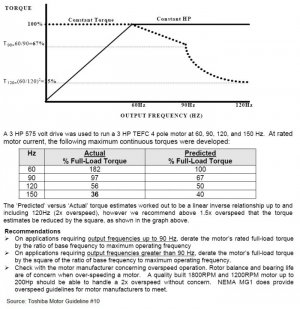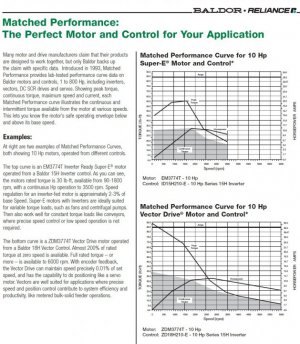- Joined
- Jan 20, 2015
- Messages
- 359
You cant run a 3450 rpm motor at 120 hz. The rotor and bearings are not rated to take that rpm, depending on the motor, either 2 pole or 4 pole inverter rated max out about 5500 to 6000.Assuming you run those motors to the same maximum VFD frequency, your example you loose half your belt SFPM. For example if 120Hz is your max frequency:
1750 RPM motor (4 pole), 3" pulley, 120Hz = 2,750 SFPM,
3500 RPM motor (2 pole), 3" pulley, 120Hz = 5,500 SFPM
If you put a 2x pulley on the 4 pole motor, the torque vs RPM curve are basically identical for the same HP motor. Changing the motor poles doesn't change this.
You could argue that you can overspeed a 1750 RPM motor to a higher frequency (say 240Hz vs 120Hz for a 2 pole 3500 RPM motor). From a rotor and bearing RPM standpoint that may be true, but from a motor electromagnetic design you are going to loose a lot of efficiency trying that. The idea that a inverter motor maintains HP above 60Hz is only true for a limited range.
You are correct about the efficiency, it starts dropping about 200 hz. Which is 5800 rpm and is at or above the rpm limit anyhow for the 4 pole and only 100 hz on a 3450.
But my whole point is with same size pulley, at max speed of the motor, things will be equal down to 120 hz on the 4 pole and 60 hz on the 2 pole or 3450 rpm. Below that the 4 pole will have a torque/hp advantage.
Last edited:



